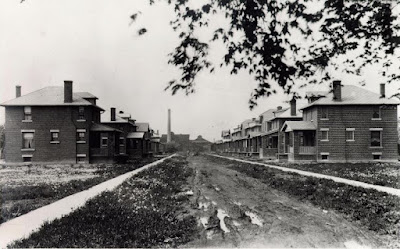An article in the October 12, 1919 issue of the
Sandusky Register reported that real
estate development had begun in an area known as Wyandotte Point, under the
impetus of
James J. Hinde, manager
of the Sandusky Development Company. The area contained 30 acres of land
adjacent to
West Monroe Street,
running from
Sandusky
Bay to land close to New
York Central railroad tracks. The name
Wyandotte Point was a nod to the Native Americans who once
lived in this vicinity. The plot was laid out prior to World War I, but
government regulations prohibited new construction during the wartime years.
Homes were to be constructed for a cost of between 3000 and
7000 dollars ($47,000-$110,000 in today's dollars), with only single family residences to
be built here for fifty years. Mr. Hinde was quoted in the
Register article, “The time is right for extensive real estate
development here. This is evident owing to the incoming of many manufacturing
plants and the need for housing. Employees and officials must have dwellings.
Another thing, as I see it, all modern home development must be in the suburbs.
The tendency of home seekers is to withdraw from city surroundings into the
more open and healthy country.”
The close proximity to Sandusky
Bay and Winnebago Park were key factors for prospective buyers of homes in Wyandotte Point. A street car line
took residents from Winnebago Park to Sandusky.
Notes on the picture below indicate that J.J. Hinde had
these homes built on Gartland
Avenue, which was close to the G and C Foundry, and namesake of one of the foundry's owners.
An advertisement in the Sandusky
Register of November 26, 1919, told prospective owners of homes in this
development that they could double their money in five years.
Winnebago
Park is now known as Lions Park.
In “The Follett House Scrapbook,” a feature in the August 23, 1987 issue of the
Sandusky
Register, Helen Hansen and Virginia Steinemann gave a brief history of Winnebago Park
and Lions Park. The park was once included in the
Wyandotte Point development.
In the 1920s through the
1950s, many family reunions were held at Winnebago
Park, later known as Lions Park.
The Sprau family gathered at Winnebago
Park in 1920.

 |
| Sandusky Register, Oct. 12, 1919 |

 this blog
this blog











2 comments:
In the ad for Wyandotte Point, It says "thouroughly restricted."
Does that mean what I suspect it means?
Although "restrictions" on which people could buy properties was rather common, it appears, based on a news article (added to the end of this post), that the Wyandotte Point restrictions were strictly about the types of buildings allowed in the development. Businesses and apartments were prohibited, and each house was required to meet a minimum sale value.
Post a Comment